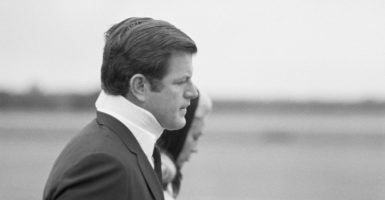It’s a long-standing tradition of the news media to run stories on the anniversaries of consequential events from the past, as they did for the 75th anniversary of D-Day on June 6.
Accordingly, for several days last week, the print and broadcast news media ran countless stories leading up to the 50th anniversary of the first-ever landing of astronauts on the moon on July 20, 1969.
As well they should have—but the 50th anniversary of another major news event that rocked Washington and the rest of the nation passed simultaneously last week, all but unremarked by the news media.
Most of the liberal mainstream media couldn’t be bothered devoting ink or airtime to recalling the events that occurred in the overnight hours of July 18-19, 1969, on Chappaquiddick Island, Edgartown, Massachusetts.
A young campaign staffer, Mary Jo Kopechne, 28, died as a result of the shameful negligence and callous indifference of one of the most powerful and influential men in Washington at the time, Sen. Edward M. “Ted” Kennedy, D-Mass.
For those too young to remember: Kennedy left a party at the family’s cottage with Kopechne and was behind the wheel of his Oldsmobile when it drove off a narrow, guardrail-less bridge into the waters of Poucha Pond off Martha’s Vineyard.
The car landed on its roof in shallow, tide-swept waters. Kennedy managed to get out, but Kopechne was not so lucky. The senator made little or no effort to rescue her, and instead trudged back to the cottage to consult with his all-male coterie of political fixers on how to extricate himself from what was certain to become a damaging political scandal.
Kennedy was widely expected to run for president in 1972, but Chappaquiddick surely quashed that, so Kennedy’s critics might say that Kopechne did not die entirely in vain.
Kennedy failed to report the accident to police, when Kopechne might still have been rescued. (She was thought to have lived for up to five hours after the accident.) He instead returned to his hotel room for the night and went to sleep, and speculation is that that was to give himself time to sober up. He finally reported it 10 hours after the fact—after the submerged Oldsmobile was discovered the next morning by a fisherman and his son.
>>> ‘Chappaquiddick’ Shows a Ted Kennedy of Complexity, Guilt
How Kennedy escaped—whether by rolling down a window or opening a door—isn’t clear, and even less clear is why Kopechne didn’t just follow him out. She either drowned, or more likely suffocated when an air pocket was exhausted. That’s also not clear, because inexplicably, there was no autopsy.
Apologists for the liberal media might argue that it had a full plate reporting on the moon landing anniversary, but that would be akin to suggesting that the media can’t walk and chew gum at the same time.
The media’s shameful “lunar eclipse” of the Chappaquiddick anniversary this past weekend underscores how the most insidious—and invidious—power of the media is the power to ignore stories that don’t fit their preferred narratives.
The death of Kopechne reflected extremely poorly on the character and judgment of Kennedy. Yet, the last survivor of Camelot went on to serve 40 more years in the Senate, right up until his death in August 2009.
Over the ensuing four decades, Kennedy became revered by the left—in and out of the media—as “the liberal lion of the Senate,” and Chappaquiddick has been dismissed by some as little more than a blemish on a sterling political career.
That likely explains why The Washington Post—at least in its print editions of Thursday, July 18, through Sunday, July 21—published not so much as a single news or Style section article or opinion column on the Chappaquiddick anniversary.
Where were the Post’s innumerable staff #MeToo’ers and social justice warrior columnists decrying how Kennedy avoided any prison time for involuntary manslaughter in Kopechne’s death? After all, isn’t Kennedy’s escaping justice the ultimate example of white male privilege?
The mainstream media also largely ignored a 2018 theatrical film re-creation, “Chappaquiddick,” with it getting few, if any, of the puff-piece articles that movies usually get in newspaper features sections—and even fewer invitations to appear for promotional purposes on the celebrityinterview shows for “Chappaquiddick” stars Jason Clarke and Kate Mara. Some of the few interviews that were conducted were confrontational and defensive of Kennedy’s reputation.
>>> Right Side of History: The Truth About Ted Kennedy and Chappaquiddick
One scene in the film depicts Kennedy wearing a medical neck brace—including at Kopechne’s funeral—a prop meant to buttress his claims of having suffered a concussion in the accident as a way to generate public sympathy—and, more importantly, to save his political career.
Kennedy’s use of the neck brace ploy was at once so transparently desperate and despicable that a December 2001 episode of TV’s police procedural drama “CSI” rightly ridiculed it. Gil Grissom’s forensics expert character described a homicide crime scene cover-up attempt as being “as phony as a Chappaquiddick neck brace.”
Too bad Grissom, or someone like him, wasn’t around on July 18, 1969, to uncover and expose the truth of what happened that night a half-century ago.
In an earlier scene in the film, Kennedy huddles with a roomful of political fixers to discuss damage control. “It’ll take nothing short of men walking on the moon to knock it off the front page,” one of those operatives remarks, referring to President John F. Kennedy’s 1961 fulfilled pledge to send astronauts to the moon before the end of the decade.
“Fortunately for us, it looks like Ted’s big brother arranged for just that.”
Regrettably, as we saw again over the weekend, the movie “Chappaquiddick” was just art imitating life—and déjà vu all over again.






























